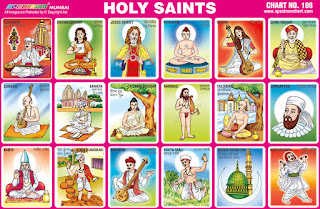Spectrum Chart - 108 : Holy Saints
- Tukaram - Tukaram was a 17th-century poet-saint of the Bhakti movement in Maharashtra. Tukaram is known for his Abhanga devotional poetry and spiritual songs known as kirtans. His poetry was devoted to Vitthala or Vithoba, an avatar of Hindu god Vishnu.
- Dnyaneshwar - Dnyaneshwar was a 13th-century Marathi saint, poet, philosopher and yogi of the Nath tradition whose Dnyaneshvari & Amrutanubhav are considered to be milestones in Marathi literature.
- Jesus Christ – Jesus, also referred to as Jesus of Nazareth, is the central figure of Christianity, whom the teachings of most Christian denominations hold to be the Son of God.
- Mahavir – Mahavir also known as 'Vardhaman', was 24th & last Jain Tirthankara. He revived the Jain Dharma with five moral teachings under broad headings of Non-violence(Ahimsa), Truthfulness (Satya), Non-stealing (Asteya), Control of senses including mind(Brahmacharya) and Non-possessiveness (Aparigraha).
- Meera - Meera, also known as Mira Bai, was a 16th century Hindu mystic poet and devotee of Krishna. She is celebrated as a poet and has been claimed by the North Indian Hindu tradition of Bhakti saints.
- Guru Nanak - Guru Nanak Dev was the founder of Sikhism, and the first of the ten Sikh Gurus. His main teaching to the world was written down to be "devotion of thought and having good actions as the first of our jobs".
- Surdas - Surdas was a late 15th-century blind saint, poet and musician, known for his devotional songs dedicated to Lord Krishna. Surdas is said to have written and composed a hundred thousand songs in his magnum opus the 'Sur Sagar'
- Eknath - Ekanath was a prominent Marathi sant, scholar, and religious poet of the Varkari sampradaya. In the development of Marathi literature, Ekanath is seen as a bridge between his predecessors—Dnyaneshwar and Namdev—and the later Tukaram and Ramdas.
- Gautam Buddha - Lord Buddha is a very holy person in Buddhism. Buddha, was a sage on whose teachings Buddhism was founded. He is believed to have lived and taught mostly in the eastern part of the Indian subcontinent sometime between the 6th and 4th centuries BCE.
- Ramdas - Ramdas was a noted 17th-century saint and spiritual poet of Maharashtra. He is most remembered for his Advaita Vendatist text, the Dasbodh. Ramdas was a devotee of Hanuman and Rama.
- Tulsidas - Tulsidas was a Hindu poet-saint, reformer and philosopher from Ramanandi Sampradaya in the lineage of Jagadguru Ramanandacharya renowned for his devotion to the Lord Rama.
- Zoraoster - Zoroaster or Zarathushtra, was an ancient prophet who lived in Persia. He founded a religion named Zoroastrianism. He is credited with the authorship of the Yasna Haptanghaiti as well as the Gathas, hymns which are at the liturgical core of Zoroastrian thinking. Most of his life is known through the Zoroastrian texts.
- Kabir - Kabir was a mystic poet and a musician and was one of the important saints of Hinduism and also considered a Sufi by Muslims. He is respected by Hindus, Muslims and Sikhs.
- Gora Kumbhar - Gora Kumbhar was a Hindu sant associated with the Bhakti movement and the Varkari sect of Maharashtra. He was a potter by trade and devotee of Vithal.
- Namdeo – Namdeo was a poet-saint from Maharashtra, who is significant to the Varkari sect of Hinduism. He is also venerated in Sikhism, as well as Hindu warrior-ascetic traditions such as the Dadupanthis and the Niranjani Sampraday.
- Savta Mali - Savata Mali (born in the 13th century) was a Hindu saint. He was a contemporary of Namdev, and a devotee of Vithoba.
- Tomb of Mohammad – Tomb of Mohammad is in the city of Medina in Saudi Arabia. Mohammad's tomb lies within the confines of what used to be his wife Aisha's and his house. Millions of visitors come to visit it every year because it is traditional to visit the mosque when going on the pilgrimage to Mecca.
- Narsinh Mehta – Narsinh Mehta was a poet-saint of Gujarat, India, notable as a bhakta, an exponent of Vaishnava poetry. He is especially revered in Gujarati literature, where he is acclaimed as its Adi Kavi.


No comments:
Post a Comment